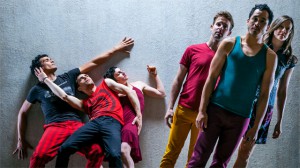Two characters, a young man and a young woman (Bert and Penny, Melicio Estrella and Damara Vita Ganley) step into two separate squares of light and declare their commitment to one another. He vows to be a fierce protector; she will try not to be a “walking scream.” Penny has been “touched in unspeakable ways,” explored against her will. Bathed in white light, the two perform a tender dance that expresses their post-trauma struggle to right themselves and make their world whole again.
And just like that I am transported to a San Francisco long past (mid-1980s), a mostly nocturnal place I explored with my own Penny in a special gay guy – straight girl bubble that those on the outside have a hard time comprehending.
We live together on top of Dolores Street sharing two rooms adjoined by a heating vent through which we talk to one another deep into the night. Lately, my Penny has been dating a pretty boy from Ohio, who drove to San Francisco on his motorcycle with a group of other, equally striking straight boys. She has a mane of bright red hair and I have a mass of long black curls; neither of us will ever be more beautiful. On Friday nights one of the local TV stations has begun playing reruns of The Avengers, forcing me to seriously consider whether going out on the prowl will be better than Emma Peel — in an era well before the DVR. Inevitably my Penny sends one of her “motorcycle boys” to pick me up at two in the morning to bring me to tonight’s party. For some reason they like having me on the back of their bikes and often steal kisses when they think no one is looking.
One night in the dead of winter, the boys show up with a young woman in tow. She is just out of the hospital, recovering from a savage attack in Golden Gate Park, where she was gang raped, stabbed repeatedly and left for dead. The boys don’t know how to show her how much they love her and how wrecked they are by what has happened to one of their own. So they bring her to us, along with several hits of ‘x’ and a brand new copy of Nick Cave and The Bad Seeds’ Your Funeral, My Trial, which plays over and over into the night.
Joe Goode always does this to me. He accesses my deepest memories, opening them up like an emotional archaeologist, carefully uncovering layers of forgotten feeling. He inspires contradictory impulses — sharing and hiding, revelation and withholding — and his latest effort, Hush, is full of this push and pull.





